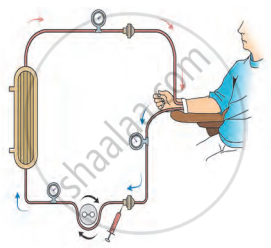Advertisements
Advertisements
Question
Complete the diagram/chart with correct labels/ information. Write the conceptual details regarding it.

Solution

- When the renal function of a person falls below 5 – 7 %, the accumulation of harmful substances in the blood begins. In such a condition, the person has to go for artificial means of filtration of blood i.e. hemodialysis.
- In haemodialysis, a dialysis machine is used to filter blood. The blood is filtered outside the body using a dialysis unit.
- In this procedure, the patients’ blood is removed; generally from the radial artery and passed through a cellophane tube that acts as a semipermeable membrane.
- The tube is immersed in a fluid called dialysate which is isosmotic to normal blood plasma. Hence, only excess salts if present in plasma pass through the cellophane tube into the dialysate.
- Waste substances being absent in the dialysate, move from the blood into the dialyzing fluid.
- The filtered blood is returned to vein.
- In this process it is essential that anticoagulant like heparin is added to the blood while it passing through the tube and before resending it into the circulation, an adequate amount of anti-heparin is mixed.
- Also, the blood has to move slowly through the tube and hence the process is slow.
APPEARS IN
RELATED QUESTIONS
What are the two ways by which a person can get relief in case of kidney failure?
How are kidney stones formed?
What are the symptoms of a urinary tract infection?
Correct the sequence of the following steps to explain the process of urine formation.
1. Blood enters the glomerulus under high pressure.
2. The filtrate passes through the thin walls of the Bowman’s capsule into the renal tubule
3. As the filtrate, passes through the tubule, water, and many useful substances are reabsorbed by the walls of the blood capillaries.
4. Water and small solutes are filtered in the Bowman’s capsule.
5. The remaining liquid, along with waste is called urine and is collected in the urinary bladder.
6. Blood containing waste material enters the kidneys through the renal artery.
Stones formed when the urinary tract is infected by urea splitting bacteria are ______
One of the factors which may help to differentiate chronic kidney disease from acute kidney injury is ______
Excretion of uric acid includes the following features EXCEPT ______
The condition of accumulation of urea in the blood is termed as ______.
The accumulation of urea in the blood due to malfunctioning of kidneys is referred to as ______.
Which statement is correct regarding the haemodialysis procedure?
